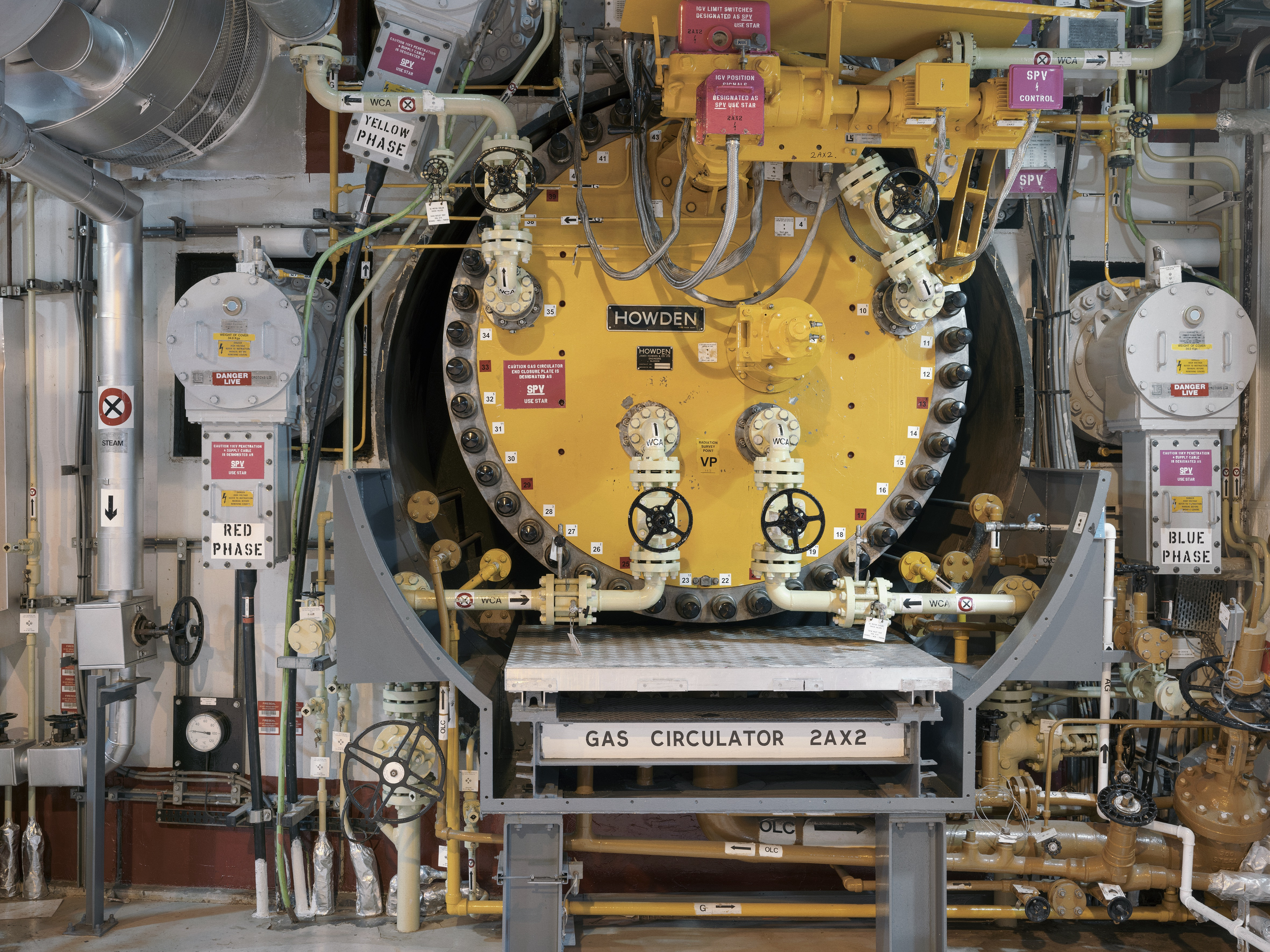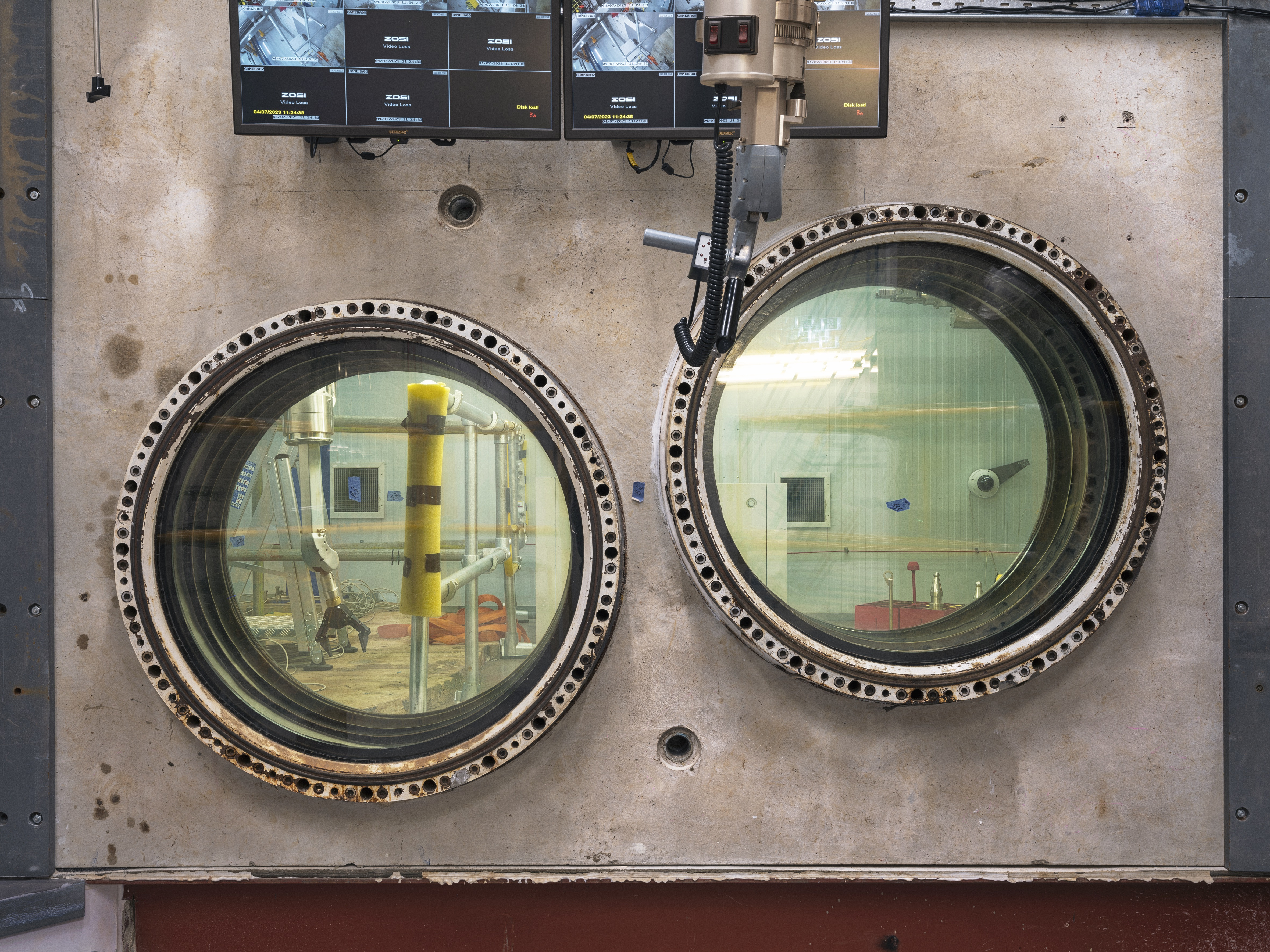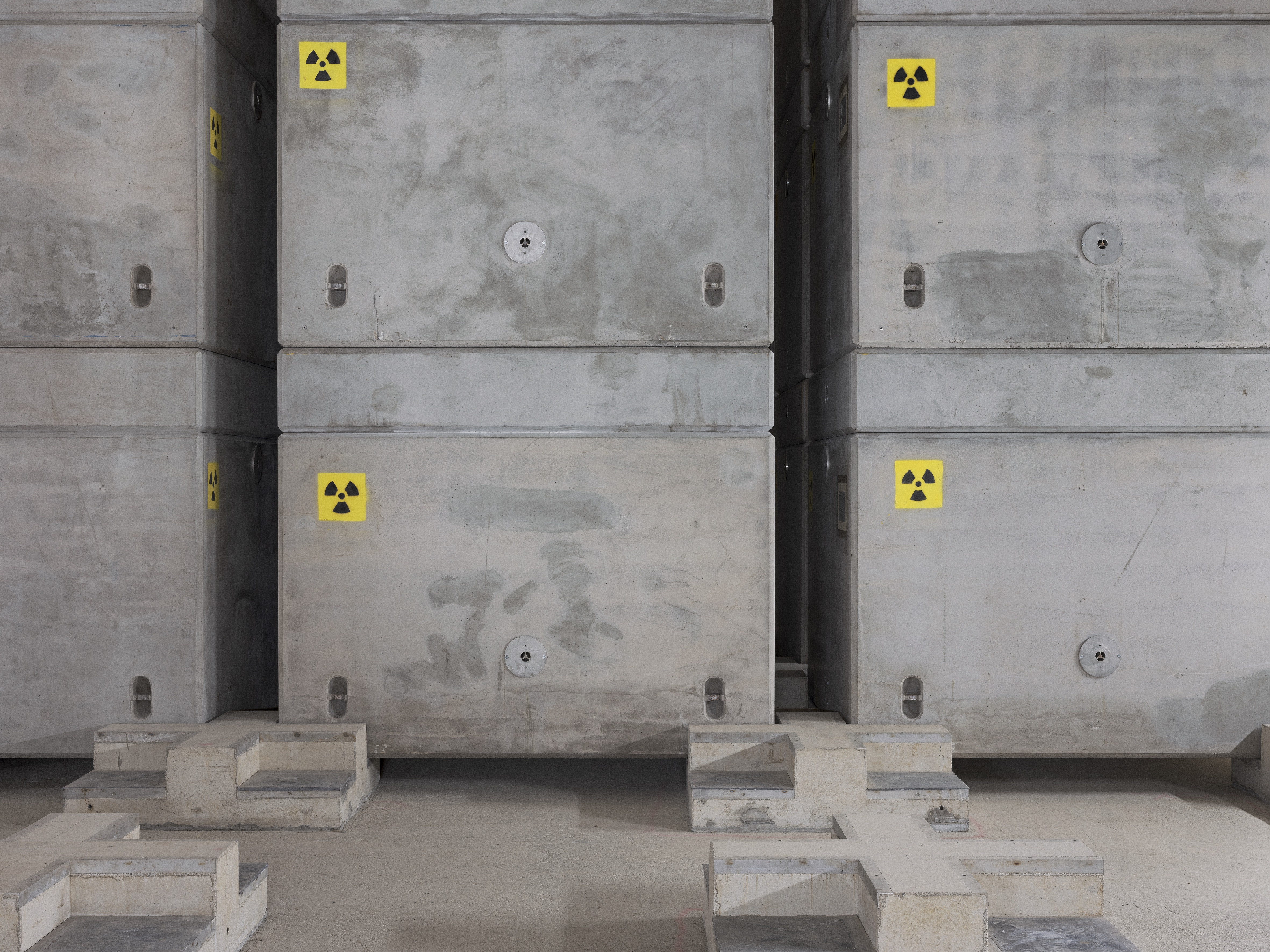Michael Collins was given access to Britain’s nuclear power stations. His photographs provide an insight into a remarkable series of spaces, once seen as the future of power generation. Some have reached the end of their working lives, and are now in the process of being dismantled. Other are still functioning, while an experimental new generation of reactors take shape, a reminder that we depend on atomic power. Writing in 1979, the American artist Robert Morris observed that, “in one form or another, technology has produced the monuments of the 20th century: the mines, the rocket assembly buildings so vast that weather forms inside, the Four Corners Power Complex, the dams of the 1930s, the linear and circular accelerators of the 1950s and 1960s, the radio telescope arrays of the 1960s and 1970s, and soon, the tunnel complex for the new MX missile.” Morris’ essay was about land art as a form of reclamation in the context of the vast opencast mines that scarred the North American landscape. In observing the monumental status of an industrial legacy, he sought to question how such sites should be viewed in the future – whether they should be afforded heritage status. In so doing, Morris asked his audience to consider the formal and material treatment of redundant structures once they had become technologically obsolete. Should they be obliterated or camouflaged, or was a better strategy to retain some memory of their presence? His argument trod a thin line between ecological sensitivity, consciousness of heritage and the commercial possibilities of commissioned art as a form of amelioration and commemoration.

Morris’ observations are increasingly prescient in Britain today, where the monuments of its post-war modernisation programme have routinely been demolished before their true significance has been explored or understood. Most of the large coal-fired power stations built in the1960s have now been decommissioned. Many of them have already been blown up, and their sites cleared.The distinctive silhouette of the parabolic cooling tower, the iconic form of power generation, was indelibly inscribed in the mind’s eye of an entire population and is steadily and purposefully being eradicated from view. The requirement for cooling water-situated power stations on low lying, level land where their massive forms were visible to any traveller on the motorway network, itself expanded in parallel with the capacity of the national grid. Motorways and carbon giants were not the only forms of new infra-structural landscapes that emerged in the post-ward ecades – where coal fired meant coal fields. The geography of Britain’s nuclear power stations was markedly more remote and almost exclusively coastal. Only Harwell and Trawsfynydd are exceptions.

To the communities that harboured atomic energy production facilities, their impact was absolute. Small settlements expanded to accommodate incoming workers. Supply chains and attendant social, cultura land essential provisions tied entire families to nuclear employment, amongst the spheres, domes and oddly cubist forms of reactor halls. In the UK, by 1976, 13, of an eventual 19, nuclear reactors were connected to the national grid from 11 sites. The first wasCalder Hall at Sellafield in Cumbria, which went on stream in 1956. The most recent nuclear power station in Britain is Sizewell B, which opened in 1995. It was the year in which nuclear-generated electricity peaked at 25 per cent of the total supply. It is down to less than 18 per cent today.
Not subject to the decarbonisation programme that drove the demolition of coal and oil-fired facilities, a generation of nuclear power stations has reached the end of its operational life. Unlike the carbon operations, the winding down of atomic sites is incremental. The half-life of spent nuclear fuel necessitates that change is at a glacial pace. From a heritage perspective, this gives time to consider the value of the old stations. It offers the opportunity to appreciate the preserved image of facilities that were founded on notions of stability and maintenance regimes that prioritised a status quo – change for change’s sake was not desirable.

The photographer Michael Collins is one of the few people who have been afforded access to all of Britain’s nuclear sites. His new book,The Nuclear Sublime, captures, in extraordinary detail, a moment and anaesthetic that is as intriguing as it is unsettling. Collins’ view though is not one of objects in a field, his is an interiorised perspective, a rare glimpse into contained space that is almost devoid of natural light, indeed devoid of nature at all. This collected series of images presents an entirely man-made environment shaped exclusively by function and, as such, defining its own order, tonal palette, and graphic catalogue.
Collins is knowledgeable about his subject. He has a long-held interest in industrial structures and land-scapes. A connection with the Financial Times opened the door to his first nuclear power station, Sellafield, and, after waiting nine months to achieve security clearance, his visit revealed to him both the archaeo-logical nature of these sites and a technological palimpsest – stasis in tandem with layering that is uniquely industrial and is amplified in nuclear sites. The photographs that he took then attracted the attention of the Nuclear Decommissioning Authority which is charged with responsibility for dealing with the afterlife of the power stations after they cease operating. The NDA sees consultation with the public as an essential part of its activities, and it was this that motivated Collins’ commission to document the stations. Collins accepted the com-mission with the proviso that he would be free from direction from the NDA. It would be understood as a creative project, rather than commercial photography. His uncompromising stance was understood and accepted by the public body and access, whilst highly controlled in terms of safety, was effectively unlimited.

His work reflects Bernd and Hilla Becher’s powerful documentation of the typologies of industrial architecture, and he shares their fascination with various forms of record photography. When Collins met theGerman artist duo in Dusseldorf, they discussed the question of the influence of the Neue Sachlichkeit photographer Albert Renger-Patzsch on their work. Bernd Becher toldCollins that the canon was not that useful to him and produced a gazette of local industry from the Siegenarea where he grew up as an example of the type of image that inspired him.
Collins has explored many archival collections and champions their inherent cultural value. For him, the period in which municipal departments and large engineering contractors routinely employed professional photographers represented documentary photography in its purest form. It has left a largely unknown but very valuable legacy of images that are yet to be fully appreciated for the technological record they contain and the corresponding socio-cultural narratives that they support. He believes they deserve statutory protection in the same way that buildings are protected by listing for their architectural or historic significance.

In Collins’ work this “most matter of fact” aesthetic is important. He seeks clarity, a depth of field, sharp-ness of focus and compositions that are revealing and not necessarily exhibiting mood or sensation. This careful and informed approach lends the photographs in this collection a neutral quality that commits the view-er to visual interrogation, every detail, mark, insignia, object, or colour has its own meaning that narrates a bigger story beyond the limits of each frame. Collins’ aim is not to document, despite employing a documentary style, and this is manifest in the images which ask more questions than they answer in their production.
Collins describes nuclear sites that have been de-commissioned as “private museums”, and their interior details as free from the interpretation of curators. His gaze into these secure spaces, admittedly personally thrilling by virtue of their inaccessibility, allows the viewer to form their own interpretations. Collins’ text accompanying his images is as precise as the photography and describes the processes of production. In so doing, Collins contextualises the contents of each image within a bigger system at the same time as liberating the viewer, allowing their own interrogation and interpretation. Fittingly they have a sense of containment, that each photograph is only giving a glimpse of a fraction of the spaces and sequences that constitute these systems. Here, the sublime is ex-pressed in the absence of a complete understanding of how a nuclear power station functions, and our inability to grasp the consequences of nuclear energy and nuclear waste. Even an apprehension of nuclear physics and fission only offers a partial grasp of the operations of such complex sites, and it is this incomplete operational perspective that is captured in the photographs and in their compilation. They are an archive record, they are traces and memories of people and processes, but they are also artefacts in their own right.

Beyond the content of each photograph, a nuclear aesthetic is made evident. Pragmatic industrial design creates its own visual image, a lexicon of function and, in this case, safety. It makes sense to demarcate functions in clearly contrasting colours. At Dungeness the pile caps – the thick concrete mats – are marked out in white on a blue floor so that a crane operator can be unequivocal in their motion. For decades designers have toyed with these aesthetics. Ben Kelly’s work for Factory Records and others is perhaps the most celebrated. The floors of the reactor halls also call to mind Sam Jacob Studio’s recent scheme for the ScienceMuseum Group’s National Collections Centre. Bothare codified spaces. However, the contrast in purpose is stark. An underlying sense of the seriousness of the codification of these operations is hard to shake and, as fascinating as their reading and interpretation is to the viewer, as beautiful as the aesthetic may seem, the images are inevitably ominous.
The book includes photographs from British nuclear power stations at Chapelcross, Dounreay, Dungeness, Sizewell, Torness, Trawsfynydd and Wylfa. However, this is more than a work to record and recall: Collins’ conception of The Nuclear Sublime extends to those facilities that are developing anew generation of power production to address the transition from carbon. The closing images are from sites researching nuclear fusion reactors in the UK and France. These new objects are not the worn, patinated, entropic surfaces of power stations past, they are crisp, cast and overwhelmingly polished stainless steel and aluminium edifices, some with their cellophane wrappers yet to be removed. More than those that preceded them, their image is “bewilderingly technological”,“challenging the limits of our comprehension”. By their inclusion Collins reminds us that the ghosts of nuclear past are not monuments to histories – in the absence of any viable alternative, they are but a staging post to a seemingly inexorable future.
The Nuclear Sublime is published by RRB Photobooks £50. A special edition including a print is available for £200. Photographs copyright Michael Collins.
This feature appeared in Issue 2 of Anima, head here to purchase a copy or subscribe